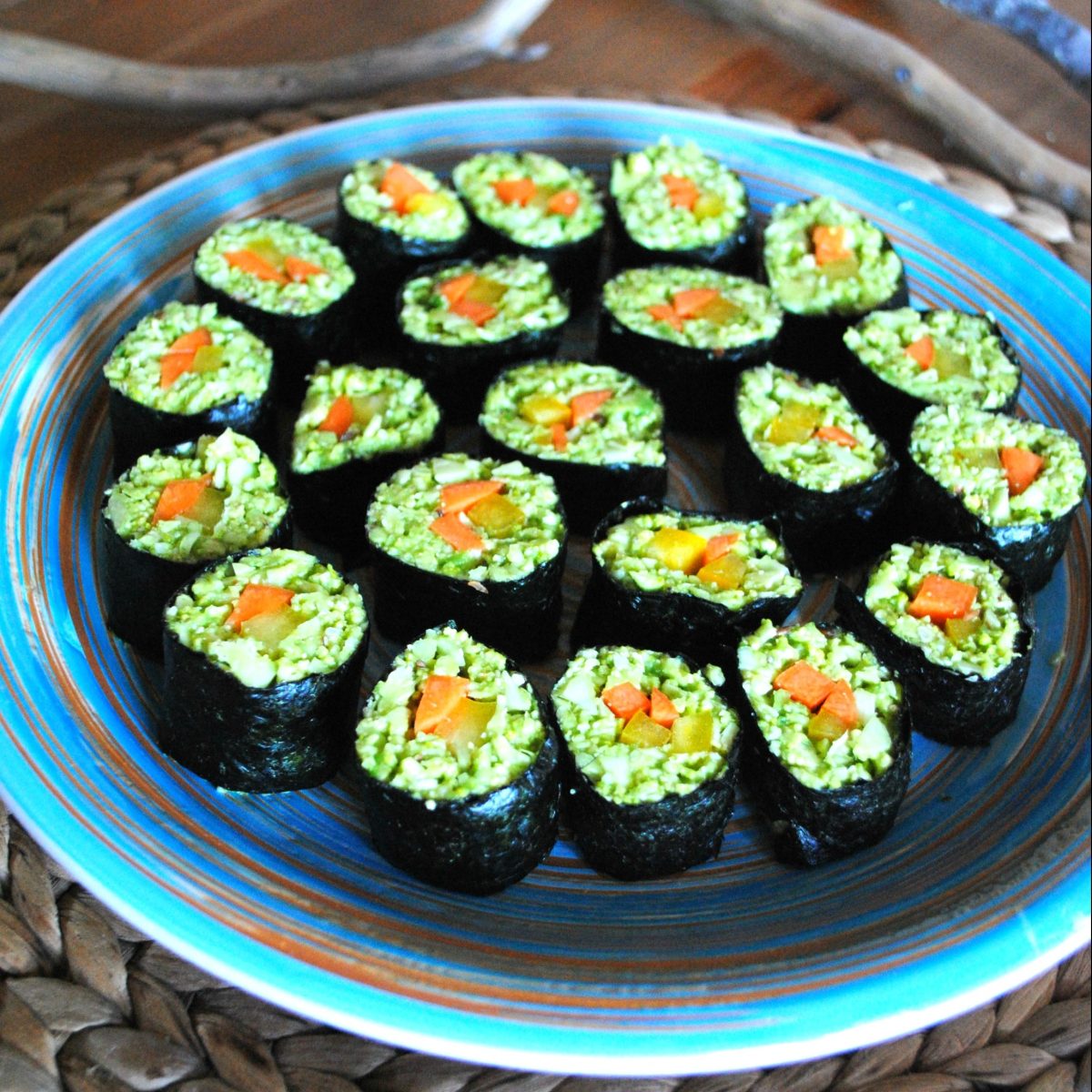Unleash your inner sushi chef and discover the vibrant world of raw vegan sushi—a culinary adventure that’s both healthy and incredibly delicious. Forget bland takeout; this guide unveils the secrets to crafting stunning, flavorful rolls that rival (and surpass!) any restaurant. Prepare to embark on a journey filled with fresh, seasonal ingredients, innovative techniques, and breathtaking presentation, transforming your kitchen into a haven of culinary creativity.
From selecting the perfect rice alternative—whether it’s fluffy cauliflower rice or subtly sweet zucchini—to mastering the art of rolling, this comprehensive guide will equip you with the knowledge and confidence to create show-stopping sushi masterpieces. Learn to artfully arrange vibrant vegetables, tangy sauces, and elegant garnishes, resulting in sushi that’s not only a feast for the palate but a visual delight as well. Get ready to impress your friends and family with sushi so exceptional, they’ll never believe it’s vegan, let alone homemade.
Ingredient Selection and Preparation
Crafting exceptional raw vegan sushi hinges on the quality and preparation of your ingredients. Selecting fresh, vibrant produce and employing precise techniques will elevate your culinary creation far beyond typical takeout. The following guide details ingredient choices, preparation methods, and flavor enhancement strategies to ensure a truly memorable dining experience.
Essential Raw Vegan Sushi Ingredients
The foundation of any great raw vegan sushi roll lies in the careful selection of its components. High-quality ingredients are paramount to achieving the desired texture and taste. Seasonal availability significantly impacts both the flavor and nutritional value of your ingredients. Prioritizing in-season produce guarantees peak freshness and optimal taste.
Rice Alternatives: Choose from options like cauliflower rice, sushi rice made from short-grain brown rice, or quinoa. Each offers a unique texture and nutritional profile. Cauliflower rice provides a light and airy texture, while brown rice offers a more substantial, nutty bite. Quinoa adds a slightly more complex flavor and a boost of protein.
Vegetables: Embrace the bounty of seasonal vegetables. In spring, opt for vibrant asparagus, crisp cucumber, and sweet snap peas. Summer brings ripe avocado, juicy mango, and colorful bell peppers. Autumn offers earthy mushrooms, roasted sweet potatoes, and vibrant carrots. Winter provides hearty daikon radish, vibrant red cabbage, and refreshing spinach. Consider using a mandoline slicer for uniformly thin slices.
Seaweed: Nori sheets are the traditional choice, providing a savory, umami flavor and a characteristic texture. Consider using other types of seaweed like wakame or dulse for variety in texture and taste.
Other Ingredients: Incorporate a variety of additions such as marinated tofu, edamame, sprouts, or thinly sliced ginger for added flavor and texture. Experiment with different combinations to create your signature sushi rolls.
Ingredient Preparation Techniques
Proper preparation is key to unlocking the full potential of each ingredient. Careful washing, precise slicing, and strategic marinating techniques all contribute to the final product’s success.
Washing: Thoroughly wash all vegetables under cold running water to remove any dirt or debris. For leafy greens, consider soaking them in a bowl of cold water for a few minutes to help remove any pesticides or lingering soil.
Slicing: Uniformly sliced ingredients are crucial for aesthetic appeal and even texture. Use a sharp knife to achieve clean, precise cuts. For delicate ingredients, a mandoline slicer can be invaluable for achieving thin, even slices. Consider using a vegetable peeler for long, thin ribbons of vegetables like carrots or zucchini.
Marinating: Marinating can significantly enhance the flavor of your ingredients. Simple marinades, such as a mixture of soy sauce (tamari for gluten-free), rice vinegar, and sesame oil, can add depth and complexity to vegetables. Allow ingredients to marinate for at least 30 minutes before assembling your sushi.
Flavor and Texture Maximization
Beyond the basic preparation, several strategies can be employed to further enhance the flavor and texture of your raw vegan sushi ingredients.
Flavor Pairing: Experiment with complementary flavor combinations. The slight sweetness of mango pairs well with the spiciness of ginger, while the earthiness of mushrooms complements the crispness of cucumber. Consider adding a dash of lime juice or a sprinkle of sesame seeds for added complexity.
Texture Contrast: Incorporate a variety of textures to create a more dynamic and interesting culinary experience. Combine soft avocado with crisp cucumber and crunchy sprouts for a delightful textural contrast.
Temperature Control: Cold ingredients maintain their crispness and freshness. Chill your vegetables before assembling your sushi for an optimal culinary experience.
Raw Vegan Sushi Rice Alternatives Comparison
| Rice Alternative | Nutritional Information (per cup cooked) | Cooking Method | Texture |
|---|---|---|---|
| Cauliflower Rice | Low in calories, high in Vitamin C and fiber. | Steam or sauté until tender-crisp. | Light and airy. |
| Brown Rice (short-grain) | High in fiber, magnesium, and manganese. | Rinse thoroughly, cook according to package directions. | Slightly chewy and nutty. |
| Quinoa | Complete protein, high in fiber and iron. | Rinse, cook in a 2:1 ratio of water to quinoa until fluffy. | Slightly firm and slightly crunchy. |
Sushi Rice Preparation

Creating the perfect base for your raw vegan sushi is crucial. The “rice” acts as the foundation, holding the other ingredients together and providing a subtly sweet and slightly tangy counterpoint to the fresh flavors. We’ll explore how to prepare delicious and textured vegan rice alternatives using cauliflower and zucchini.
Proper rinsing and preparation of the chosen “rice” is paramount for achieving the ideal texture and preventing a gummy or watery final product. The goal is to create a rice that holds its shape while offering a pleasant mouthfeel. Seasoning adds the finishing touch, enhancing the overall flavor profile and complementing the other ingredients in your sushi.
Cauliflower Rice Preparation
Cauliflower rice offers a light and fluffy texture, ideal for vegan sushi. Its mild flavor readily absorbs seasonings, allowing for culinary creativity.
- Rice Preparation: Begin by finely ricing a head of cauliflower using a food processor fitted with a grating disc or by hand-grating. The finer the rice, the better it will mimic the texture of traditional sushi rice.
- Rinsing and Draining: Place the riced cauliflower in a fine-mesh sieve and rinse thoroughly under cold water. This removes excess starch and any lingering cauliflower odor. Gently press to remove excess moisture. An image here would show a person rinsing the cauliflower rice in a sieve under running water, with clear water running through the sieve.
- Seasoning: In a bowl, combine the drained cauliflower rice with 2 tablespoons of rice vinegar, 1 tablespoon of maple syrup, 1 teaspoon of sesame oil, and a pinch of sea salt. Gently toss to coat evenly. A picture would show a mixing bowl with the cauliflower rice and seasonings, illustrating the even coating.
- Resting: Allow the seasoned cauliflower rice to rest for at least 15 minutes, allowing the flavors to meld. An image could depict the seasoned cauliflower rice resting in a bowl, ready for use.
Zucchini Rice Preparation
Zucchini rice provides a slightly more substantial texture compared to cauliflower rice, offering a different mouthfeel experience. Its mild flavor profile also makes it a versatile base.
- Rice Preparation: Use a vegetable peeler or a julienne peeler to create long, thin strands of zucchini. Then, finely chop these strands to create a rice-like consistency. A photo here would showcase the transformation of a zucchini into thin strands and then into a rice-like texture.
- Rinsing and Draining: While not as crucial as with cauliflower, a quick rinse under cold water can help remove any excess moisture. Gently squeeze out any excess water. The image here would show the zucchini rice being gently squeezed to remove excess moisture.
- Seasoning: Combine the zucchini rice with 1 tablespoon of rice vinegar, ½ tablespoon of lemon juice, ½ teaspoon of nutritional yeast (for a cheesy flavor), and a pinch of salt and pepper. A photo would show the zucchini rice being tossed with the seasonings in a bowl.
- Resting: Allow the seasoned zucchini rice to rest for at least 10 minutes to allow the flavors to blend. An image could illustrate the seasoned zucchini rice resting in a bowl before use.
Seasoning Techniques and Flavor Combinations
Experimentation is key to finding your perfect vegan sushi rice seasoning. Beyond the basic recipes above, explore a range of flavors to create unique culinary experiences.
- Spicy: Add a pinch of red pepper flakes or a dash of sriracha for a spicy kick.
- Savory: Incorporate a teaspoon of tamari or coconut aminos for a savory depth.
- Herbaceous: Add finely chopped fresh herbs like cilantro, dill, or chives for a refreshing aroma and taste.
- Citrusy: A squeeze of lime or orange juice can brighten the flavor profile.
Creating raw vegan sushi that eclipses takeout is within your reach. This guide has armed you with the knowledge, techniques, and inspiration to craft vibrant, flavorful, and visually stunning rolls. Remember the importance of fresh, high-quality ingredients, the precision of your rolling technique, and the artistry of presentation. With each roll you create, you’ll refine your skills, unlocking a world of culinary possibilities. So, gather your ingredients, embrace your creativity, and prepare to amaze yourself and others with your newfound sushi mastery.
Query Resolution
What are some good substitutes for nori seaweed?
Large lettuce leaves, rice paper, or even thinly sliced cucumber can serve as excellent nori substitutes.
How long can I store leftover raw vegan sushi?
Store leftover sushi in an airtight container in the refrigerator for up to 24 hours. It’s best enjoyed fresh.
Can I use pre-made vegan sushi rice?
While you can, making your own allows for better control over seasoning and texture. Pre-made options may contain added sugars or preservatives.
What are some creative filling ideas beyond the basics?
Experiment with marinated tofu, avocado, mango, bell peppers, edamame, sprouts, and various colorful vegetables. The possibilities are endless!


